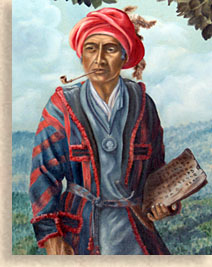George Gist, better known as “Sequoyah,”
George Gist, better known as “Sequoyah,” was a Cherokee mixed blood of Scottish descent. Sequoyah  lived on the western side of the Smoky Mountains along the Little Tennessee River and considered himself an illiterate man. Thinking along these lines, he made attempts at formulating a means of writing for his people to understand and use for communication. He failed numerous times until he took up a copy of the Bible, the McGuffey Reader and a Greek text, from which he began to make simple signs, each representing what he considered were the eighty-six distinct sounds in the Cherokee language. After many trials and attempts, along with his own personal tribulations with his wife and neighbors thinking he was crazy “claiming he could make paper talk,” he was even beginning to believe them. lived on the western side of the Smoky Mountains along the Little Tennessee River and considered himself an illiterate man. Thinking along these lines, he made attempts at formulating a means of writing for his people to understand and use for communication. He failed numerous times until he took up a copy of the Bible, the McGuffey Reader and a Greek text, from which he began to make simple signs, each representing what he considered were the eighty-six distinct sounds in the Cherokee language. After many trials and attempts, along with his own personal tribulations with his wife and neighbors thinking he was crazy “claiming he could make paper talk,” he was even beginning to believe them.
Completing a set of works, he taught his daughter the symbols and sounds. Visitors were so amazed that he and his daughter could communicate on paper they thought it was, trickery or worse, witchcraft. After teaching several other kids how to talk on paper the Cherokee Syllabary became wide spread throughout the Cherokee Nation, leading to the first development of a newspaper on tribal lands. The “Phoenix,” printed in both Cherokee Syllabary and English began publishing in 1828 at the new developing Cherokee City of New Echota in Georgia. The paper was successful yet short lived due to the government’s Indian Removal Act of 1830, ending those dreams of further assimilating with the white settlers. The Cherokee even created their own Constitution after the new nation of the United States’ Constitution yet to no avail.
Photo of painting taken at Sequoyah Birthplace Museum in Vonroe, Tennessee.
|
|
|
|

Sign
up for the Blue Ridge Highlander Newsletter, Messages from the Mountains
to find out first about our new feature stories, road trips and special offers
Your e-mail addresses will not be sold or given away to anyone.
Highlander Privacy
Policy
Let our visitors tell you about the Highlander...
Click the feathers to go to the Highlander site
map...
designed, produced and hosted by

The Blue Ridge Highlander logo, all photography, design, graphics, artwork,
writing, digital images, etc are the Copyright ©
of C. Wayne Dukes and Sherry Bell Dukes. 1996 - 2017, except where otherwise
stated. All rights reserved, reproduction,
downloading, and/or
duplication of any sort is strictly prohibited, all violations will be prosecuted. Legal Policy.
If
you have any questions, or comments, regarding this site, e-mail the Highlander. |

 lived on the western side of the Smoky Mountains along the Little Tennessee River and considered himself an illiterate man. Thinking along these lines, he made attempts at formulating a means of writing for his people to understand and use for communication. He failed numerous times until he took up a copy of the Bible, the McGuffey Reader and a Greek text, from which he began to make simple signs, each representing what he considered were the eighty-six distinct sounds in the Cherokee language. After many trials and attempts, along with his own personal tribulations with his wife and neighbors thinking he was crazy “claiming he could make paper talk,” he was even beginning to believe them.
lived on the western side of the Smoky Mountains along the Little Tennessee River and considered himself an illiterate man. Thinking along these lines, he made attempts at formulating a means of writing for his people to understand and use for communication. He failed numerous times until he took up a copy of the Bible, the McGuffey Reader and a Greek text, from which he began to make simple signs, each representing what he considered were the eighty-six distinct sounds in the Cherokee language. After many trials and attempts, along with his own personal tribulations with his wife and neighbors thinking he was crazy “claiming he could make paper talk,” he was even beginning to believe them. 






